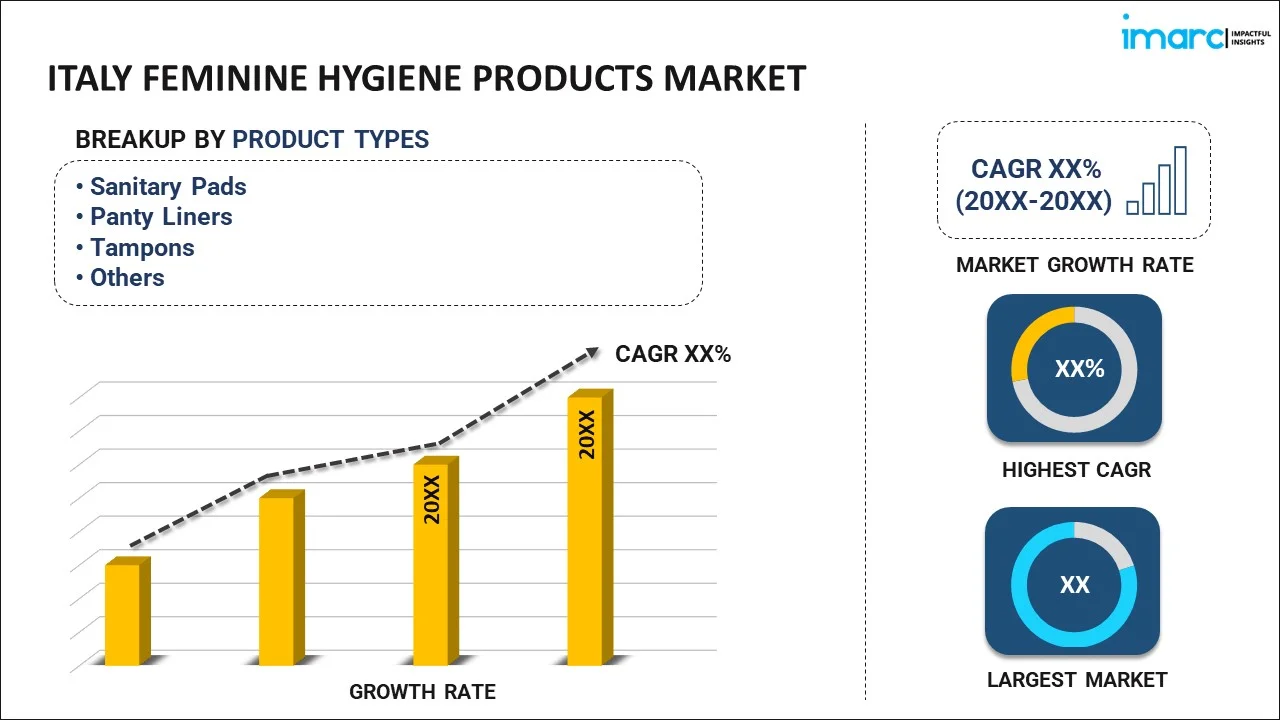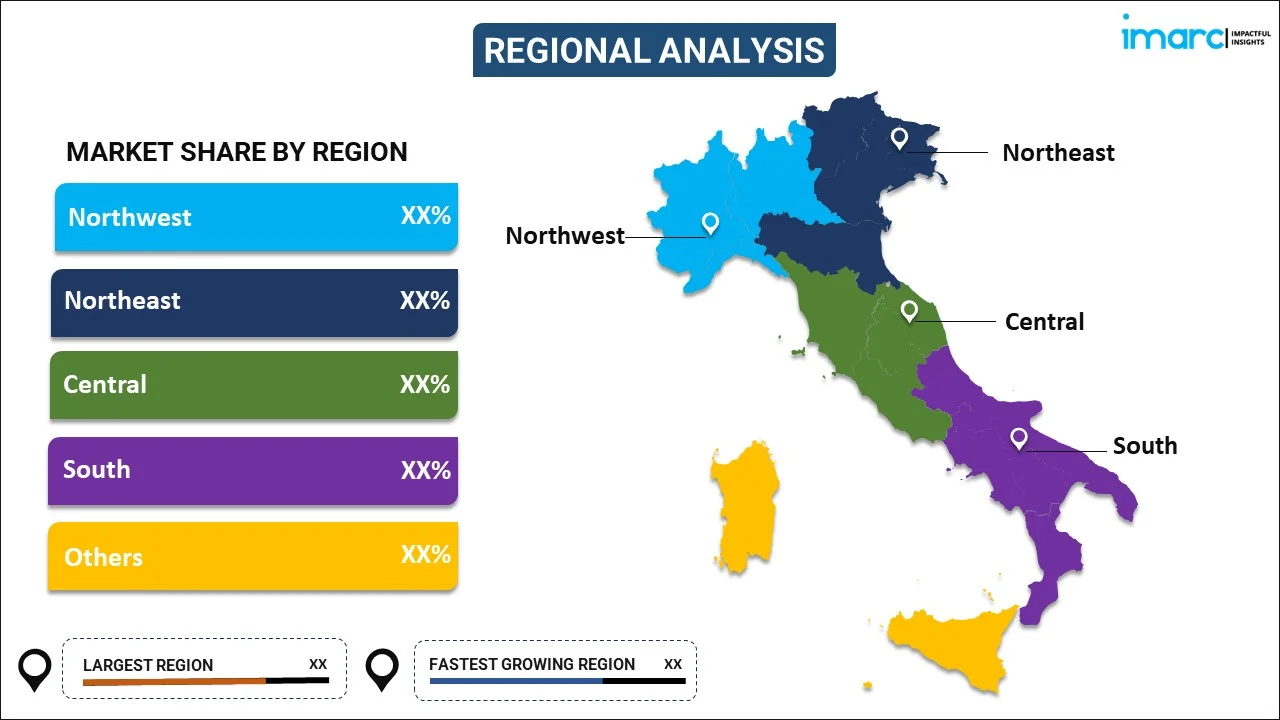
Italy Feminine Hygiene Products Market Report by Product Type (Sanitary Pads, Panty Liners, Tampons, Spray and Internal Cleaners, and Others), Distribution Channel (Supermarkets and Hypermarkets, Specialty Stores, Beauty Stores and Pharmacies, Online Stores, and Others), and Region 2025-2033
Italy Feminine Hygiene Products Market Overview:
The Italy feminine hygiene products market size reached USD 675.1 Million in 2024. Looking forward, IMARC Group expects the market to reach USD 984.4 Million by 2033, exhibiting a growth rate (CAGR) of 4.28% during 2025-2033. The increasing awareness about menstrual health, rising disposable income, widespread adoption of innovative and eco-friendly products, rapid urbanization, improved retail infrastructure, and rising marketing campaigns and education initiatives are some of the major factors propelling the market growth.
|
Report Attribute
|
Key Statistics
|
|---|---|
|
Base Year
|
2024
|
|
Forecast Years
|
2025-2033
|
|
Historical Years
|
2019-2024
|
|
Market Size in 2024
|
USD 675.1 Million |
|
Market Forecast in 2033
|
USD 984.4 Million |
| Market Growth Rate 2025-2033 | 4.28% |
Italy Feminine Hygiene Products Market Trends:
Advent of Innovative and Eco-friendly Products
The introduction of innovative and eco-friendly products, such as organic and biodegradable sanitary items, attracts environmentally conscious consumers, boosting the market demand. For instance, Corman, the manufacturer of Organyc products, has long been in the natural feminine care space. The Milan, Italy-based company introduced the first range of 100% cotton feminine care pads in the early 1990s. Today, Organyc is the only clinically-proven period protection for women, manufacturing and marketing pads, liners and tampons using 100% certified organic cotton fully, both outside where the products touch the skin and inside where they absorb.
Increasing Awareness and Education
The growing awareness about menstrual health and hygiene through educational campaigns and public health initiatives encourages the use of feminine hygiene products. For instance, Italy’s parliament has begun discussing a possible new law that would provide an official “menstrual leave” policy, granting women three paid days off each month. While one side has hailed the possibility as a progressive move that finally acknowledges the fact that some women have painful periods, the other side believes it would cement stereotypes of female weakness and be a step backward for feminism.
Rising Disposable Income
Higher disposable incomes enable women to spend more on quality and innovative hygiene products, leading to market growth. According to the data from the OECD Better Life Index, In Italy, the average household net-adjusted disposable income per capita is USD 29 431 a year, slightly lower than the OECD average of USD 30,490 a year. Some 67% of men are in paid work, compared with 49% of women. In Italy, 3% of employees work very long hours in paid work, below the OECD average of 10%, with 4% of men working very long hours in paid work compared with 2% of women. In Italy, 63% of adults aged 25-64 have completed upper secondary education, lower than the OECD average of 79%. However, completion varies between men and women, as 61% of men have completed high school compared with 65% of women.
Italy Feminine Hygiene Products Market News:
In January 2024, Coop Italia pledged to absorb a recent VAT increase on sanitary pads in Italy and has reactivated a campaign to reduce the tax rate on these and other feminine care products.
In May 2023, repairing the world is the new standard of sustainability, and Corman of Milan, Italy, and Tosama of Slovenia have met this new standard with the first ever biodegradable and compostable plastic tampon applicator, soon to be launched by the Organyc brand. Plastic applicator tampons have been a mainstay in period care for decades. But the waste generated from these applicators stays around for centuries. An average user of tampons for period care generates nearly a kilogram of plastic waste per year.
Italy Feminine Hygiene Products Market Segmentation:
IMARC Group provides an analysis of the key trends in each segment of the market, along with forecasts at the country level for 2025-2033. Our report has categorized the market based on product type and distribution channel.
Product Type Insights:

To get more information on this market, Request Sample
- Sanitary Pads
- Panty Liners
- Tampons
- Spray and Internal Cleaners
- Others
The report has provided a detailed breakup and analysis of the market based on the product type. This includes sanitary pads, panty liners, tampons, spray and internal cleaners, and others.
Distribution Channel Insights:
- Supermarkets and Hypermarkets
- Specialty Stores
- Beauty Stores and Pharmacies
- Online Stores
- Others
A detailed breakup and analysis of the market based on the distribution channel have also been provided in the report. This includes supermarkets and hypermarkets, specialty stores, beauty stores and pharmacies, online stores, and others.
Regional Insights:

- Northwest
- Northeast
- Central
- South
- Others
The report has also provided a comprehensive analysis of all the major regional markets, which include Northwest, Northeast, Central, South, and Others.
Competitive Landscape:
The market research report has also provided a comprehensive analysis of the competitive landscape in the market. Competitive analysis such as market structure, key player positioning, top winning strategies, competitive dashboard, and company evaluation quadrant has been covered in the report. Also, detailed profiles of all major companies have been provided.
Italy Feminine Hygiene Products Market Report Coverage:
| Report Features | Details |
|---|---|
| Base Year of the Analysis | 2024 |
| Historical Period | 2019-2024 |
| Forecast Period | 2025-2033 |
| Units | Million USD |
| Scope of the Report | Exploration of Historical Trends and Market Outlook, Industry Catalysts and Challenges, Segment-Wise Historical and Future Market Assessment:
|
| Product Types Covered | Sanitary Pads, Panty Liners, Tampons, Spray and Internal Cleaners, Others |
| Distribution Channels Covered | Supermarkets And Hypermarkets, Specialty Stores, Beauty Stores and Pharmacies, Online Stores, Others |
| Regions Covered | Northwest, Northeast, Central, South, Others |
| Customization Scope | 10% Free Customization |
| Post-Sale Analyst Support | 10-12 Weeks |
| Delivery Format | PDF and Excel through Email (We can also provide the editable version of the report in PPT/Word format on special request) |
Key Questions Answered in This Report:
- How has the Italy feminine hygiene products market performed so far and how will it perform in the coming years?
- What is the breakup of the Italy feminine hygiene products market on the basis of product type?
- What is the breakup of the Italy feminine hygiene products market on the basis of distribution channel?
- What are the various stages in the value chain of the Italy feminine hygiene products market?
- What are the key driving factors and challenges in the Italy feminine hygiene products?
- What is the structure of the Italy feminine hygiene products market and who are the key players?
- What is the degree of competition in the Italy feminine hygiene products market?
Key Benefits for Stakeholders:
- IMARC’s industry report offers a comprehensive quantitative analysis of various market segments, historical and current market trends, market forecasts, and dynamics of the Italy feminine hygiene products market from 2019-2033.
- The research report provides the latest information on the market drivers, challenges, and opportunities in the Italy feminine hygiene products market.
- Porter's five forces analysis assist stakeholders in assessing the impact of new entrants, competitive rivalry, supplier power, buyer power, and the threat of substitution. It helps stakeholders to analyze the level of competition within the Italy feminine hygiene products industry and its attractiveness.
- Competitive landscape allows stakeholders to understand their competitive environment and provides an insight into the current positions of key players in the market.
Need more help?
- Speak to our experienced analysts for insights on the current market scenarios.
- Include additional segments and countries to customize the report as per your requirement.
- Gain an unparalleled competitive advantage in your domain by understanding how to utilize the report and positively impacting your operations and revenue.
- For further assistance, please connect with our analysts.
 Request Customization
Request Customization
 Speak to an Analyst
Speak to an Analyst
 Request Brochure
Request Brochure
 Inquire Before Buying
Inquire Before Buying




.webp)




.webp)












